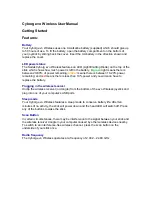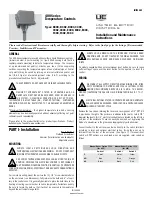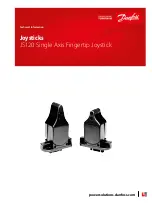
Exit from calibration by pressing button
■
.
CONFIGURATION PARAMETERS
To get access to the parameter configuration menu, press button
■
+ for 5 seconds.
With button
■
or
select the parameter to be modified.
Press button
■
to display the value.
By keeping button
■
pressed, use button
or to set the desired value.
When button
■
is released, the newly programmed value is stored and the following parameter is displayed.
To exit from the setup, press button
■
or wait for 30 seconds.
PAR
RANGE DESCRIPTION
SCL
1°C;
2°C;
°F
Readout scale (see table of input specifications)
Caution: upon changing the
SCL
value, it is then absolutely necessary to reconfigure the param-
eters relevant to the absolute and relative temperatures (
SPL
,
SPH
,
1SP
,
1HY
etc..)
SPL
-50°...SPH
Minimum limit for
1SP
setting
SPH
SPL...150°
Maximum limit for
1SP
setting.
1SP
SPL... SPH Setpoint (value to be maintained in the room).
1CM
HY; PID
Control mode.
With
1CM
=HY you select control with hysteresis: parameters
1HY
,
1T0
and
1T1
are used.
With
1CM
=PID you select a Proportional-Integral-Derivative control mode: parameters
1PB
,
1IT
,
1DT
,
1AR
,
1CT
will be used
1CH
REF; HEA
Refrigerating (REF) or Heating (HEA) control mode.
1CM
=HY
1HY
0...19.9°
OFF/ON thermostat differential. With
1HY
=0 the output is always off.
1T0
0...30min
Minimum off time.
After output 1 has been turned off, it remains inactive for
1T0
minutes regardless of the
temperature value measured.
1T1
0...30min
Minimum on time. (
the following parameter will be
1PF
).
After output 1 has been turned on, it remains active for
1T1
minutes regardless of the temperature
value measured.
1CM
=PID
1PB
0...19.9°
Proportional bandwidth.
Temperature control takes place by changing the
ON time of the output: the closer the temperature
to the setpoint, the less time of activation. A small
proportional band increases the promptness of
response of the system to temperature variations,
but tends to make it less stable. A purely
proportional control stabilises the temperature
within the proportional band but does not cancel
the deviation from setpoint.
With
1PB
=0 the output is always off.
1IT
0...999s
Integral action time.
The steady-state error is cancelled by inserting an
integral action. The integral action time, determines
the speed with which the steady-state temperature
is achieved, but a high speed (
1IT
low) may be the
cause of overshoot and instability in the response.
With
1IT
=0 the integral control is disabled.
1DT
0...999s
Derivative action time.
Response overshoot may be reduced by inserting
a derivative Action. A high derivative action (
1DT
high) makes the system very sensitive to small
temperature variations and causes instability. With
1DT
=0 the derivative control is disabled.
1AR
0...100%
Reset of integral action time referred to
1PB
Decreasing the parameter
1AR
reduces the integral control action zone, and consequently the
overshoot (see figure on paragraph
1IT
).
1CT
1...255s
Cycle time.
It’s the period in which the output ON time changes. The quicker the system to be controlled
reacts to temperature variations, the smaller the cycle time must be, in order to obtain higher
temperature stability and less sensitivity to load variations.
1PF
ON/OFF
Output state in case of probe failure.
OAU
NON;
THR;
AL0;
AL1
AUX output operation.
NON : output disabled (always off). (
the next parameter will be
ATM
)
THR: output programmed for second thermostat control (
the next parameter will be
2SM
).
AL0: contacts open when an alarm condition occurs (
the next parameter will be
ATM
).
AL1: contacts make when an alarm condition occurs (
the next parameter will be
ATM
).
OAU
=THR
2SM
ABS;
REL
Setpoint 2 mode.
Channel 2 setpoint may be absolute (
2SM
=ABS), or a differential relative to setpoint 1 (
2SM
=REL)
2SM
=ABS
2SP
SPL...SPH Auxiliary output switchover temperature (
the next parameter will be
2CH
)
2SM
=REL
2DF
-19.9...19.9°
Temperature differential relative to
1SP
. The auxiliary output setpoint is equal to
1SP
+
2DF
ON/OFF refrigerating control
(
1CM
=HY,
1CH
=REF)
ON/OFF heating control
(
1CM
=HY,
1CH
=HEA)
1SP 1SP+1HY
T[°]
ON
OFF
1SP
1SP-1HY
T[°]
ON
OFF
Time
Temperature
Process
temperature
Overshoot
Steady-state error
1PB
1SP
Time
Temperature
Process
temperature
Overshoot
1PB
1PBx1AR%
integral control
action area
1SP
Time
Temperature
Process
temperature
Overshoot
1PB
1SP
2SP 2SP+2HY T[°]
ON
OFF
2SP
2SP-2HY
T[°]
ON
OFF
ON/OFF control in refrigeration
(
2SM
=ABS,
2CH
=REF)
ON/OFF control in heating
(
2SM
=ABS,
2CH
=HEA)
1SP+2DF
1SP
2DF>0
1SP+2DF+2HY
T[°]
ON
OFF
1SP
1SP+2DF
2DF<0
1SP+2DF-2HY
T[°]
ON
OFF
ON/OFF control in refrigeration. Setpoint 2
relative to setpoint 1 (
OAU
=THR,
2CH
=REF)
ON/OFF control in heating. Setpoint 2
relative to setpoint 1 (
OAU
=THR,
2CH
=HEA)
TECHNICAL DATA
Power supply
AC1-5…D 12Vac/dc ±10%, 2W
AC1-5...W 110 - 230Vac±10%, 50/60Hz, 2W
Relay outputs (AC1-5..R..)
OUT1
12(4)A
OUT2
7(2)A
SSR drive (AC1-5..M..)
OUT1
15mA 12Vdc
Inputs
see table of input specifications
Measurement range
see table of input specifications
Measurement accuracy
see table of input specifications
Operating conditions
-10 … +50°C; 15%...80% U.R.
CE (Reference Norms)
EN60730-1; EN60730-2-9;
EN55022 (Class B); EN50082-1
Front protection
IP55
VIA PADOVA, 25
31046 ODERZO /TV /ITALY
TEL. +39 - 0422 815320
FAX +39 - 0422 814073
www.lae-electronic.com
E-mail: [email protected]
OAU
=THR
2CH
REF; HEA
Refrigerating control (REF) or heating control mode (HEA) for the auxiliary output.
2HY
0...19.9°
Differential of thermostat 2. With
2HY
=0 the auxiliary output always remains off.
2T0
0...30min
Minimum off time.
After output 2 has been turned off, it remains inactive for
2T0
minutes regardless of the temperature
value measured.
2T1
0...30min
Minimum on time.
After output 2 has been turned on, it remains active for
2T1
minutes regardless of the temperature
value measured.
2PF
ON/OFF
Auxiliary output state in case of probe failure.
ATM
NON;
ABS;
REL
Alarm threshold management.
NON: all temperature alarms are inhibited (
the following parameter will be
SB
).
ABS: the values programmed in
ALA
and
AHA
represent the real alarm thresholds.
REL: the values programmed in
ALR
and
AHR
are alarm differentials referred to
1SP
and
1SP
+
1HY
.
ATM
=ABS
ALA
-50°...AHA Low temperature alarm threshold.
AHA
ALA...150° High temperature alarm threshold.
ATM
=REL
ALR
-12.0...0°
Low temperature alarm differential.
With
ALR
=0 the low temperature alarm is excluded
AHR
0...12.0°
High temperature alarm differential.
With
AHR
=0 the high temperature alarm is excluded
ATD
0...120min
Delay before alarm temperature warning.
SB
NO/YES
Stand-by button enabling.
INP
0mA/4mA,
T1/T2
ST1/SN4
Sensor input selection (see table of input specifications).
In the models AC1-5A..., AC1-5J..., AC1-5T... only.
RLO
-19.9...RHI
Minimum range value (
in the models AC1-5A…, AC1-5I… only
)
RLO
takes the minimum value measured by the transmitter (i.e. the value matching 0V, 0/4mA).
RHI
RLO...99.9
Maximum range value (
in the models AC1-5A…, AC1-5I… only
)
RHI
takes the maximum value measured by the transmitter (i.e. the value matching 1V, 20mA)
OS1
-12.5...12.5° Probe T1 offset.
TLD
1...30min
Delay for minimum temperature (TLO) and maximum temperature (THI) logging.
SIM
0...100
Display slowdown
ADR
1...255
AC1-5 address for PC communication
INPUT SPECIFICATIONS
MODEL
INPUT
RANGE [MEASUREMENT ACCURACY]
SCL=1°C
SCL=2°C
SCL=°F
AC1-5A...
0÷1V
RLO÷RHI [< ± 3mV]
---
AC1-5I...
INP = 0mA
0÷20mA
RLO÷RHI [< ± 0.2mA]
---
INP = 4mA
4÷20mA
AC1-5J...
INP=T1
TC “J”
---
-50÷750°C [ < ±3°C ]
-60÷999°F [ < ±5°F ]
INP=T2
TC “K”
---
-50÷999°C [ < ±3°C ]
AC1-5P...
PT100
-50/-19.9÷99.9/150°C
[ < ±0.3°C ]
-100÷850°C
[ <±1°C(-50÷850°), ±2°C ]
-150÷999°F
[ <±2°F(-60÷999°), ±4°F]
AC1-5T...
INP=ST1
PTC 1000 Ω
(LAE ST1..)
-50/-19.9 ÷ 99.9/150°C
[<±0.3°C(-30÷130°),±1°C]
-50 ÷ 150°C
[<±0.3°C(-30÷130°), ±1°C]
-60 ÷ 300°F
[< ±0.6°F(-20÷260°),±2°F]
INP=SN4
NTC 10K Ω
(LAE SN4..)
-40/-19.9 ÷ 99.9/125°C
[<±0.3°C(-40÷100°),±1°C]
-40 ÷ 125°C
[<±0.3°C(-40÷100°),±1°C]
-40 ÷ 260°F
[<±0.6°F(-40÷210°), ±2°F]
WIRING DIAGRAMS
1SP
1SP-ALR
T[°]
ON
OFF
1SP+1HY+AHR
1SP
1SP-1HY-ALR
1SP+AHR
T[°]
ON
OFF
Temperature alarm with relative thresholds,
refrigerating control (
ATM
=REL,
1CH
=REF)
Temperature alarm with relative thresholds,
heating control (
ATM
=REL,
1CH
=HEA).
AC1-5AS2RW-B
data I/O
115...
~
230V
OUT2
RS485
7(2)A
OUT1
12(4)A
rH
V
9 10 11
V
IN
V+
V-
1
2
3
4
5
6
7
AC1-5JS2RW-A
data I/O
115...
~
230V
OUT2
TTL
7(2)A
OUT1
12(4)A
+
-
10
11
1
2
3
4
5
6
7
AC1-5PS2MW-B
data I/O
115...
~
230V
OUT2
RS485
7(2)A
1
2
12V
OUT1
15mA
SSR
+
-
W R W
9 10 11
1
2
4
5
6
7
AC1-5TS2RW-A
data I/O
115...
~
230V
OUT2
TTL
7(2)A
OUT1
12(4)A
10
11
1
2
3
4
5
6
7
DISPLAY
During normal operation, the display shows either the temperature measured or one of the following indications:
OFF
Controller in stand-by
TUN/xx.x
Controller in autotuning
OR
Probe T1 overrange or failure
E1
In tuning: timeout1 error
HI
Room high temperature alarm
E2
In tuning: timeout2 error
LO
Room low temperature alarm
E3
In tuning: overrange error
MENU INFO
The information available in this menu is:
THI
Maximum temperature recorded
LOC
Keypad state lock
TLO
Minimum temperature recorded
Access to menu and information displayed.
Press and immediately release button
■
.
With button
■
or select the data to be displayed.
Press button
■
to display value.
To exit from the menu, press button
■
or wait for 10 seconds.
Reset of THI, TLO recordings
With button
■
or select the data to be reset.
Display the value with button
■
.
While keeping button
■
pressed, use button
.
CHANNEL 1 SETPOINT
(display and modification of desired temperature value)
Press and release button
■
: the LED L1 blinks, the display shows 1SP for 1 second and then the setpoint associated value.
Press buttons
■
or
to set the desired value (adjustment is within the minimum
SPL
and maximum
SPH
limit).
To store the new value press button
■
, or wait for 10 seconds.
To go back to normal mode without saving the new value, press
■
.
CHANNEL 2 SETPOINT
With the auxiliary output set as thermostat control (
■
OAU
=THR), it’s possible to modify setpoint 2 during the normal operation
of the controller.
Press and release button
■
: the LED L2 blinks, the display shows 2SP for 1 second if setpoint 2 is an absolute threshold
(
2SM
=ABS), alternatively the display shows 2DF, if setpoint 2 is a threshold relative to setpoint 1 (
2SM
=REL), then the value
associated to the parameter appears.
Press buttons
■
or to set the desired value.
To store the new value press button
■
or wait for 10 seconds.
To go back to normal mode without saving the new value, press
■
.
STAND-BY
Button
, when pressed for 3 seconds, allows the controller to be put on a standby or output control to be resumed (with
SB
=YES only).
KEYPAD LOCK
The keypad lock avoids undesired, potentially dangerous operations, which might be attempted when the controllers is operating
in a public place. In the INFO menu, set parameter
LOC
=YES to inhibit all functions of the buttons. To resume normal operation
of keypad, adjust setting so that
LOC
=NO.
CONTROLLER AUTOTUNING IN PID MODE
Before starting
In the setup mode (see configuration parameters): set
1CM
=PID; make sure that
1CH
matches the desired operation mode
(
1CH
=REF for refrigerating control,
1CH
=HEA for heating control); then adjust setpoint
1SP
at the desired value.
Start autotuning
During normal operation, keep buttons
+
pressed for 3 seconds. 1CT blinks on the display. With
+ or set the cycle
time in order to define the dynamic of the process to be controlled. To abort the autotuning function, press
; to start autotuning
press +
or wait for 30 seconds.
During autotuning
During the entire autotuning phase, the display alternates TUN with the actual temperature measured. In case of power failure,
when power is resumed, after the initial autotest phase, the controller resumes the autotuning function. To abort the autotuning,
without modifying the previous control parameters, keep button pressed for 3 seconds. After the autotuning has taken place
successfully, the controller updates the control parameters and start to control.
Errors
If the autotuning function failed, the display shows an error code:
E1 timeout1 error: the controller could not bring the temperature within the proportional band. Increase
■
1SP
in case of heating
control, vice versa, decrease
1SP
in case of refrigerating control and re-start the process.
E2 timeout2 error: the autotuning has not ended within the maximum time allowed (1000 cycle times). Re-start the autotuning
■
process and set a longer cycle time
1CT
.
E3 temperature overrange: check that the error was not caused by a probe malfunction, then decrease
■
1SP
in case of heating
control, vice versa increase
1SP
in case of refrigerating control and then re-start the process.
To eliminate the error indication and return to the normal mode, press button
■
.
Control improvement
To reduce overshoot, reduce the integral action reset
■
1AR
To increase the response speed of the system, reduce the proportional band
■
1PB
. Caution: doing this makes the system less stable.
To reduce swings in steady-state temperature, increase the integral action time
■
1IT
; system stability is thus increased, although
its response speed is decreased.
To increase the speed of response to the variations in temperature, increase the derivative action time
■
1DT
. Caution: a high
value makes the system sensitive to small variations and it may be a source of instability.
RECALIBRATION
Have a precision reference thermometer or a calibrator to hand. Ensure that
■
OS1
=0 and
SIM
=0.
Switch the controller off then on again.
■
During the auto-test phase, press buttons
■
+
and keep them pressed till the controller shows
0AD
.
With buttons
■
and select
0AD
or
SAD
:
0AD
allows a calibration of 0, inserting a constant correction over the whole scale
of measurement.
SAD
allows a calibration of the top part of the measurement scale with a proportional correction between the
calibration point and 0.
Press
■
to display the value and then use + or
to make the read value coincide with the value measured by the
reference instrument.
OPERATION
Insert the controller through a hole measuring 71x29 mm;
■
Make sure that electrical connections comply with the paragraph “wiring diagrams”. To reduce the effects of electromagnetic
■
disturbance, keep the sensor and signal cables well separate from the power wires.
Fix the controller to the panel by means of the suitable clips, by pressingly gently; if fitted, check that the rubber gasket adheres
■
to the panel perfectly, in order to prevent debris and moisture infiltration to the back of the instrument.
ATTENTION: during the setup of the controller, please make sure that the parameter INP matches the sensor used, as indicated
■
in the table “input specifications”.
Place the probe T1 inside the room in a point that truly represents the temperature of the stored product.
■
INSTALLATION
OUT1
OUT2
L1
L2
Channel 1 output
Channel 2 output
Alarm
Channel 1 setpoint modification
Channel 2 setpoint modification
Info / Enter button
Fig.1 - Front panel
Modify Setpoint 1 / Decrease button
Increase / Modify Setpoint 2 button
Exit / Stand-by button.
Thank you for having chosen a LAE electronic product. Before installing the instrument, please read these instructions carefully
to ensure maximum performance and safety.
DESCRIPTION
INDICATION
AC1-5 INSTRUCTION FOR USE
Содержание LTR-5 Series
Страница 1: ...Lots of Options just One Choice...
Страница 2: ...L ots of O ptions just O ne C hoice...
Страница 18: ...L ots of O ptions just O ne C hoice...
Страница 49: ...Applications Upright refrigerators plug in and supermarket display cases cold stores control panels...
Страница 60: ...OUT1 START 16 4 A 4 5 6 230V 1 2 10 11 TMR15E A...
Страница 63: ...WBS 01Web Server Wireless Plant Monitoring Monitoring Logging and Programming Software TAB...
Страница 68: ...The TAB software incorporates an easy to use network configuration and management tool...











































